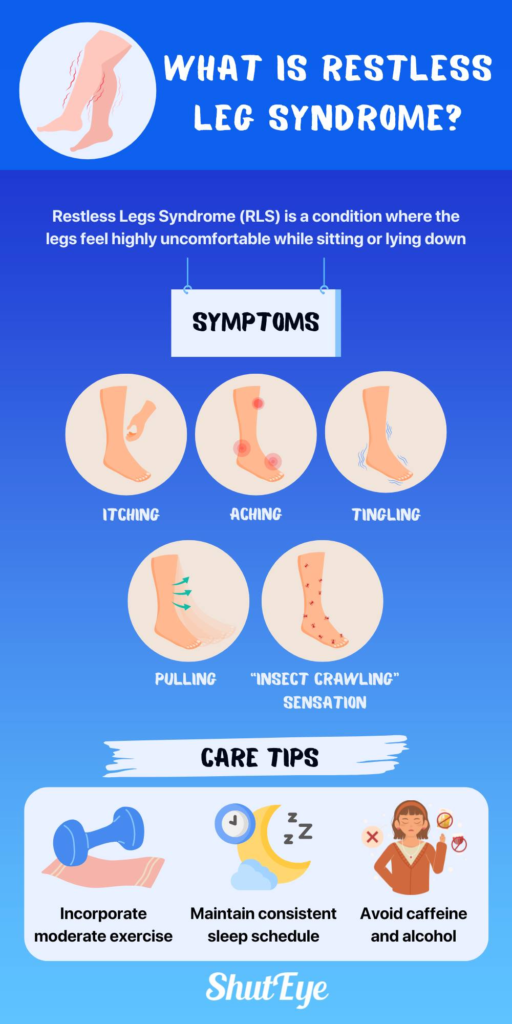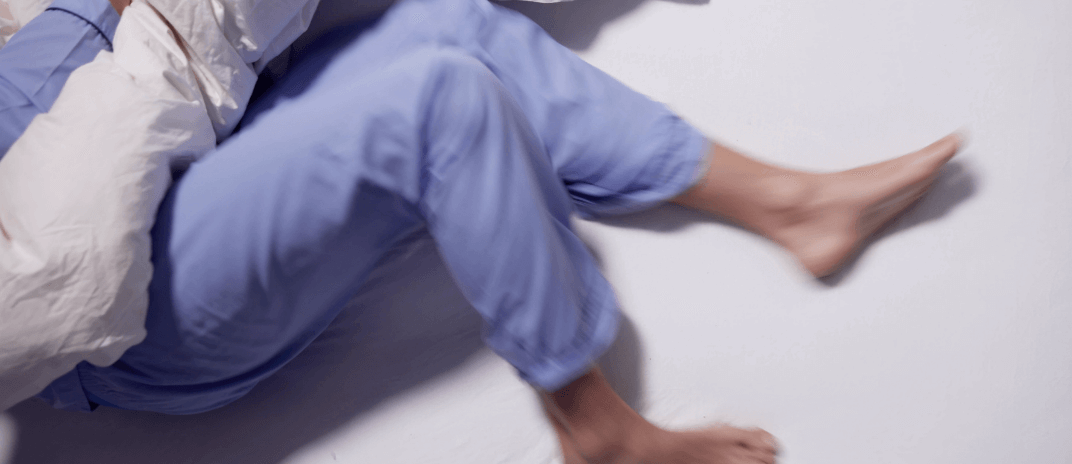Do you struggle with the constant urge to move your legs, especially at night? Restless Leg Syndrome (RLS) might be the cause of those uncomfortable sensations. This article delves into the symptoms, causes, and treatment options for RLS.
From aching legs to disruptions in daily life, managing RLS can be tough. Learn how genetics, iron deficiency, and medications play a role in RLS, and discover coping strategies to help relieve your symptoms, improve your quality of life, and sleep better.
What is a Restless Leg Syndrome?
Restless Legs Syndrome (RLS), also known as Willis-Ekbom Disease (WED), is a condition where the legs feel highly uncomfortable while sitting or lying down. Individuals with RLS experience an irrepressible urge to move their legs, often accompanied by abnormal sensations like burning, tingling, aching, or the feeling of “insects crawling under the skin.” These sensations are transiently relieved by any small movement, and RLS exhibits a strong circadian influence, with symptoms worse in the evening.
Classification of RLS
RLS is categorized into two main types: Primary and Secondary RLS. Primary RLS, also termed idiopathic, occurs without any underlying medical issues. On the other hand, secondary RLS is triggered by medical problems such as pregnancy, alcohol addiction, iron deficiency, among others.
Epidemiology
The prevalence rate of Restless Legs Syndrome (RLS) ranges from 5% to 15% in the general population. Approximately 2.5% of adults with RLS experience severe symptoms requiring medical intervention. Several risk factors associated with RLS include being female, pregnancy, low iron levels, lower socioeconomic status, poor health, and older age. Additionally, common comorbidities include Parkinson’s disease, a positive family history of RLS, and psychiatric disorders. It’s worth noting that RLS can pose challenges, making both sleeping and traveling difficult and uncomfortable.
Symptoms of Restless Leg Syndrome
If you experience an urge to move your legs, especially at night, you might be exhibiting symptoms of Restless Leg Syndrome (RLS). These cases of restless legs syndrome often manifest as uncomfortable sensations in your legs, such as itching, pulling, or aching, creating an overpowering need to shift or move your legs.
The sensations can vary in intensity, typically worsening in the evening and improving in the early morning. It’s essential to note that these symptoms are neurological in nature and can impact your daily life, especially disrupting your sleep.
If you find yourself dealing with these uncomfortable sensations and urges, seeking evaluation and guidance from a healthcare professional can help in managing and addressing the symptoms of restless legs syndrome effectively.
Restless Legs Syndrome Causes
The causes of restless legs syndrome can be attributed to various factors, including an imbalance in brain chemical dopamine and identified genetic sites associated with RLS.
- Imbalance in brain chemical dopamine affecting muscle movement control
- Genetic predisposition with identified sites linked to RLS
- Onset before age 40 more common, but RLS can develop at any age
Understanding these causes can shed light on why individuals experience the urge to move their legs and the uncomfortable sensations associated with restless leg syndrome.
While not usually connected to serious medical conditions, factors like dopamine levels and genetic influences play a significant role in the development of RLS. Seeking medical guidance and exploring management options can help alleviate the symptoms and improve the quality of life.

Risk Factors for RLS
Exploring potential risk factors for developing restless legs syndrome involves considering family history, low iron levels, and related conditions like neuropathy and renal disease. Individuals with a family history of restless leg syndrome are at a higher risk of developing the condition. Low iron levels in the brain can also contribute to the onset of RLS symptoms. Additionally, medical conditions such as neuropathy and renal disease are associated with an increased likelihood of experiencing restless legs syndrome.
Diagnosis of RLS
To diagnose restless legs syndrome, consider family history, iron levels, and related conditions. When evaluating for RLS, healthcare providers may:
- Assess your family history to identify any genetic predisposition.
- Conduct blood tests to check for iron deficiency, which can exacerbate symptoms.
- Rule out other conditions that may mimic RLS symptoms, such as leg cramps or arthritis.
Seeking a healthcare professional’s guidance is essential for an accurate diagnosis and appropriate treatment plan. By addressing these key factors, you can work towards managing the urge to move your legs, improving your quality of life, and finding relief from the discomfort associated with restless leg syndrome.
Treatment Options for People With RLS
Consider involving your healthcare provider to explore effective treatment options for managing restless legs syndrome. Treatment for RLS aims to alleviate symptoms and improve quality of life. Medications like dopaminergic agents can help regulate dopamine levels in the brain, reducing leg discomfort.
Iron supplements may be prescribed if low iron levels are detected, as this imbalance can trigger RLS symptoms. Lifestyle adjustments such as avoiding stimulants like caffeine and alcohol, maintaining a regular sleep schedule, and engaging in moderate exercise can also aid in symptom management.
Additionally, addressing any underlying medical conditions that may worsen RLS, like peripheral neuropathy or kidney failure, is essential for comprehensive treatment. Collaborate with your healthcare provider to create a personalized treatment plan tailored to your specific needs
Medications for RLS
Discuss with your healthcare provider potential medications for managing restless legs syndrome, focusing on alleviating symptoms and enhancing your quality of life.
- Dopaminergic Agents: Help regulate dopamine levels in the brain, improving movement control and reducing RLS symptoms.
- Anticonvulsants: Can be effective in managing nerve-related sensations and reducing leg discomfort during rest.
- Opioids: Reserved for severe cases where other medications have been ineffective, providing relief from intense RLS symptoms.
These medications aim to target the underlying causes of restless legs syndrome, such as dopamine imbalance and nervous system dysfunction, to alleviate the sensations and urge to move your legs, ultimately improving your daily life and sleep quality. Be sure to follow your healthcare provider’s recommendations for the most effective treatment plan.

Lifestyle Changes for RLS
Implementing a balanced exercise routine can significantly aid in managing restless legs syndrome, contributing to symptom alleviation and enhancing overall well-being. Lifestyle changes play a crucial role in the management and prevention of RLS symptoms. Making simple adjustments can have a positive impact on your condition. Here are some effective lifestyle changes for RLS:
| Lifestyle Changes | Description |
|---|---|
| Regular Exercise | Symptoms usually disappear after moderate physical activity. |
| Healthy Sleep Habits | Maintain a consistent sleep schedule to improve rest and minimize RLS triggers. |
| Balanced Diet | Consume iron-rich foods and avoid excessive caffeine and alcohol intake. |
Coping Strategies for RLS
Utilize lifestyle adjustments and coping techniques to effectively manage the symptoms of Restless Legs Syndrome (RLS). Here are some strategies to help you cope with the sensations and challenges that RLS presents:
- Establish a Relaxing Bedtime Routine: Create a calming pre-sleep ritual to relax your mind and body, promoting better sleep quality.
- Practice Stress-Relief Techniques: Engage in activities like yoga, meditation, or deep breathing exercises to alleviate stress, which can exacerbate RLS symptoms.
- Maintain Regular Physical Activity: Incorporate moderate exercise into your routine to help manage RLS symptoms and improve overall well-being.
Impact on Quality of Life
To understand the impact of Restless Legs Syndrome on your quality of life, consider the disruptive nature of the condition’s symptoms. Moderate to severe RLS can lead to uncomfortable sensations in your legs, affecting your ability to rest and causing nighttime leg twitching that disrupts your sleep.
This disturbance in your sleep pattern can result in decreased quality of life, potentially leading to daytime fatigue, irritability, and difficulty concentrating on tasks. Seeking proper treatment for RLS and effectively managing the condition is crucial in minimizing its impact on your daily life.
RLS Complications
Restless Legs Syndrome (RLS) is associated with several complications, including:
- Early Morning Rebound:
- Reappearance of RLS symptoms early as medication effects wear off.
- Insomnia:
- RLS is recognized as the 4th leading cause of insomnia, with sleep disturbance being a primary reason for seeking medical attention among individuals with RLS.
- Augmentation:
- A treatment-related side effect characterized by increased severity of RLS symptoms. It is the most concerning long-term complication of dopaminergic treatment and can result in more severe symptoms than before treatment.
- Mood Disorders:
- Common comorbid conditions include mood swings, depression, and anxiety.
- Vascular Risk Factors:
- RLS may be associated with vascular risk factors like hypertension, diabetes, and obesity.
Relationship With PLMS
Understanding the relationship between Restless Leg Syndrome and Periodic Limb Movement of Sleep is essential for effectively managing these conditions. Here are key points to consider:
- The majority of individuals with restless legs syndrome (RLS) also experience periodic limb movement disorder during sleep.
- Periodic limb movement disorder involves involuntary leg twitching every 15 to 40 seconds, impacting sleep quality.
- While RLS and periodic limb movement are often linked, it’s important to note that not all individuals with periodic limb movement disorder have restless legs syndrome.
Research and Advancements
Exploring the latest research findings and advancements in treating Restless Leg Syndrome can provide valuable insights into managing this neurological disorder effectively. Recent studies have focused on understanding the connection between restless legs syndrome (RLS) and other neurological disorders like stroke, investigating how leg movements and sensations in the legs are linked to RLS symptoms.
Advances in diagnosis and treatment have led to improved methods for accurately identifying RLS, such as utilizing advanced imaging techniques to study brain signaling pathways and genetic influences. Researchers are also exploring new treatment options, including innovative medications and therapies, to enhance symptom management and overall quality of life for individuals living with RLS.
Stay informed about these developments to better navigate the complexities of RLS management.

Intervention
Behavior Management:
Interventions involving behavioral changes include:
- Relaxation Techniques: Engage in relaxation techniques like meditation, yoga, and listening to relaxing sounds to help unwind before bedtime.
- Mind Distraction: Distract the mind by activities such as reading a book or solving a crossword puzzle while waiting for sleep.
- Altered Sleep Patterns: Doctors may recommend adjusting sleep patterns, such as going to bed and waking up later, for individuals with RLS.
Monitoring Diary:
During RLS treatment, a monthly efficacy assessment is conducted to determine whether symptoms have improved or disappeared and whether daily life has returned to normal.
Prevention
Experts recommend the following tasks to prevent RLS:
- Treatment of Primary Diseases: Address underlying conditions such as diabetes, Parkinson’s, renal failure, etc.
- Healthy Lifestyle Choices: Avoid excessive smoking, alcohol, and coffee consumption.
- Balanced Nutrition: Maintain balanced and adequate nutrition, incorporating high-protein foods like eggs and milk, along with vitamin-rich fruits and vegetables.
- Iron Supplements for Pregnant Women: Pregnant women or those who have recently given birth should consider suitable iron supplements to minimize the likelihood of RLS.
- Regular Sleep Schedule: Establish a regular sleep schedule by avoiding late nights and managing stress.
- Moderate Physical Exercise: Engage in moderate physical exercise to support overall well-being and potentially reduce RLS symptoms.
Support Resources for RLS
Continue your journey in managing Restless Legs Syndrome by exploring the support resources available to help you cope with this neurological disorder.
Here are some valuable support resources for RLS:
- Join a local or online support group for individuals experiencing restless legs syndrome symptoms, where you can connect with others facing similar challenges and share coping strategies.
- Seek out professional counseling or therapy to help you navigate the emotional toll of living with RLS and develop effective coping mechanisms for dealing with the condition.
- Explore educational resources from reputable organizations like the Restless Legs Syndrome Foundation, providing information on treatment options for moderate to severe cases of RLS and offering guidance on managing the condition effectively.
Conclusion
In conclusion, if you find yourself struggling with the urge to constantly move your legs, especially at night, it may be due to Restless Legs Syndrome (RLS). By recognizing the symptoms, causes, and treatment options for RLS, you can take proactive steps towards managing this challenging condition.
With the right support and care, you can improve your quality of life and get a good night’s rest. Don’t hesitate to seek help and explore coping strategies to alleviate your symptoms.














